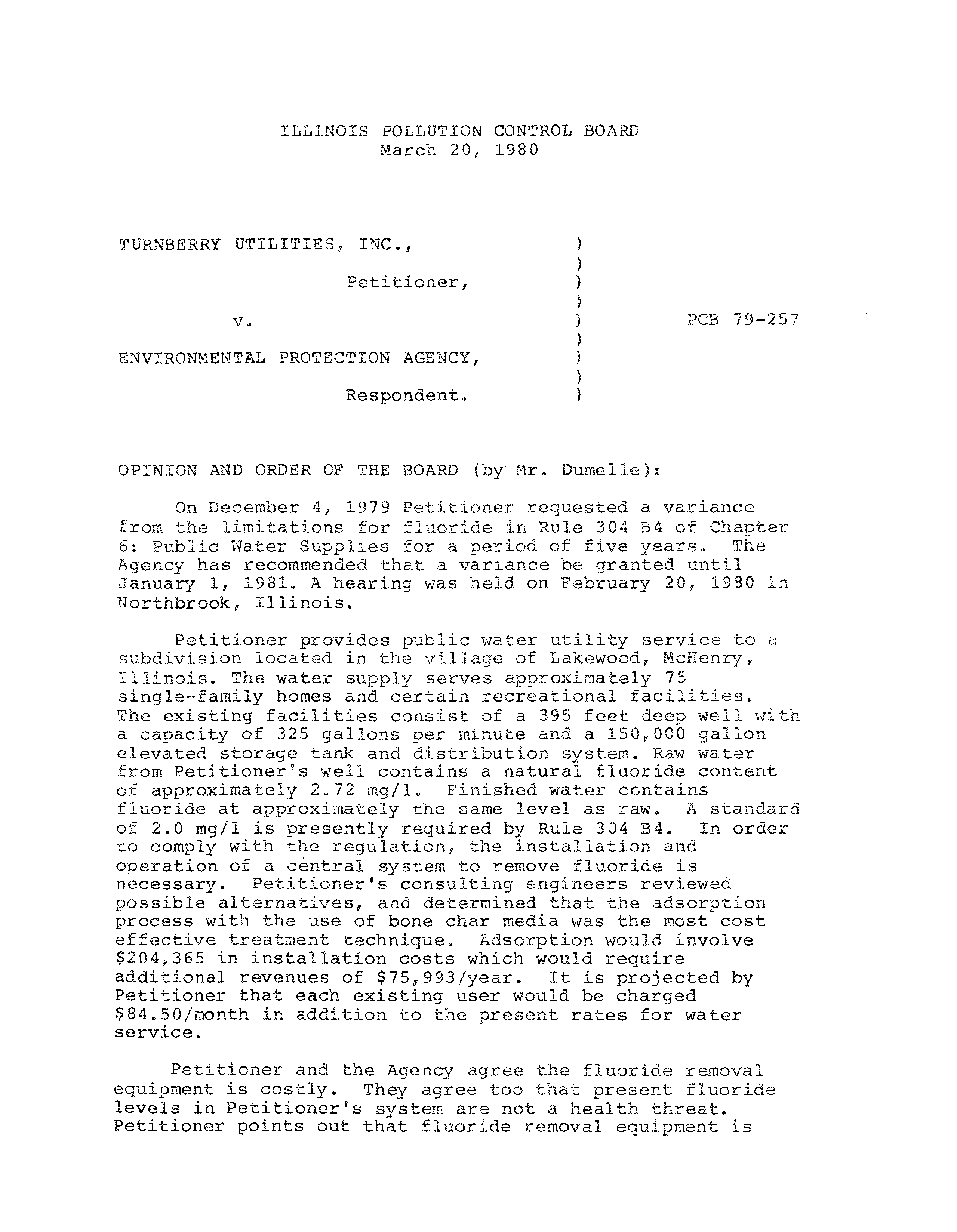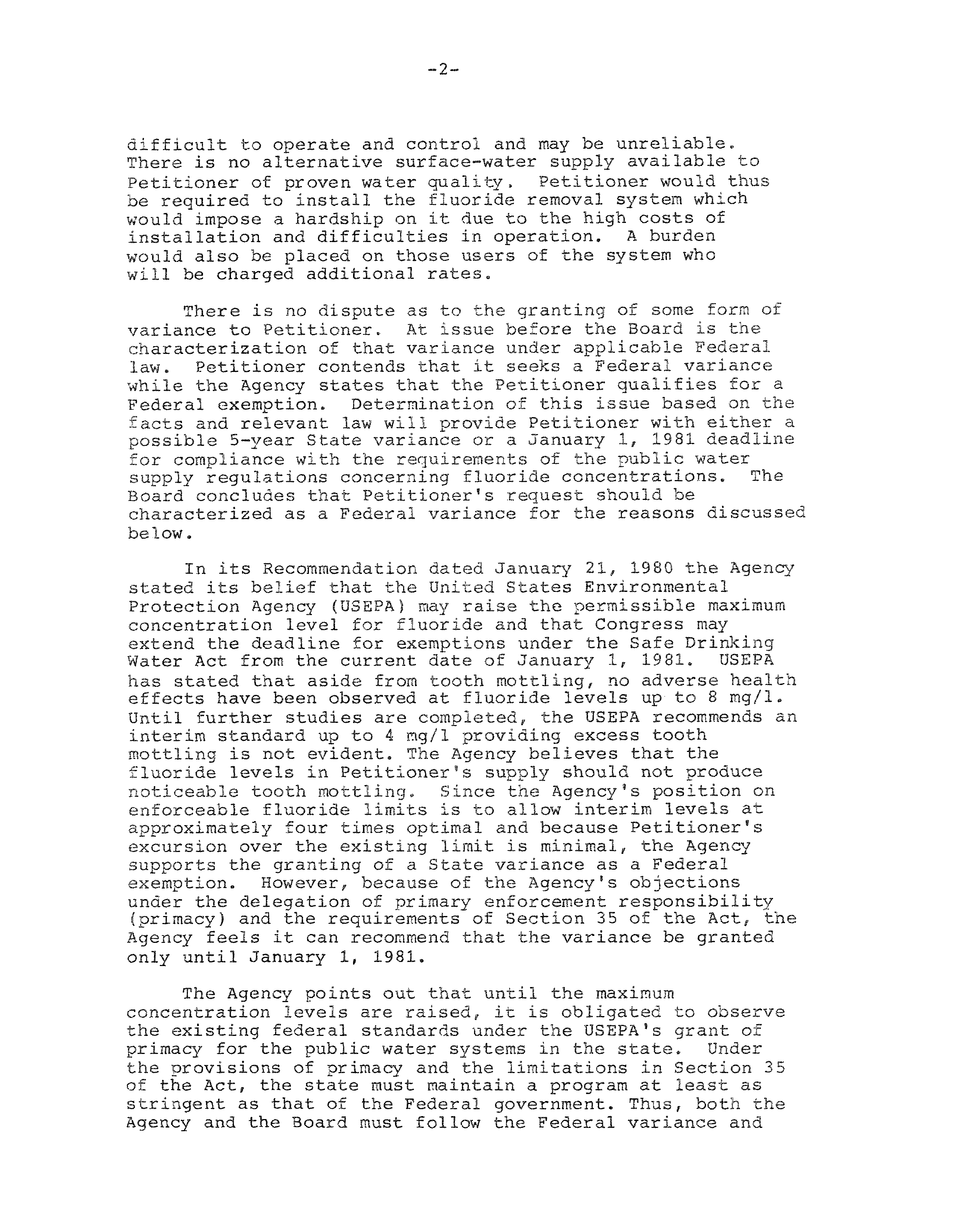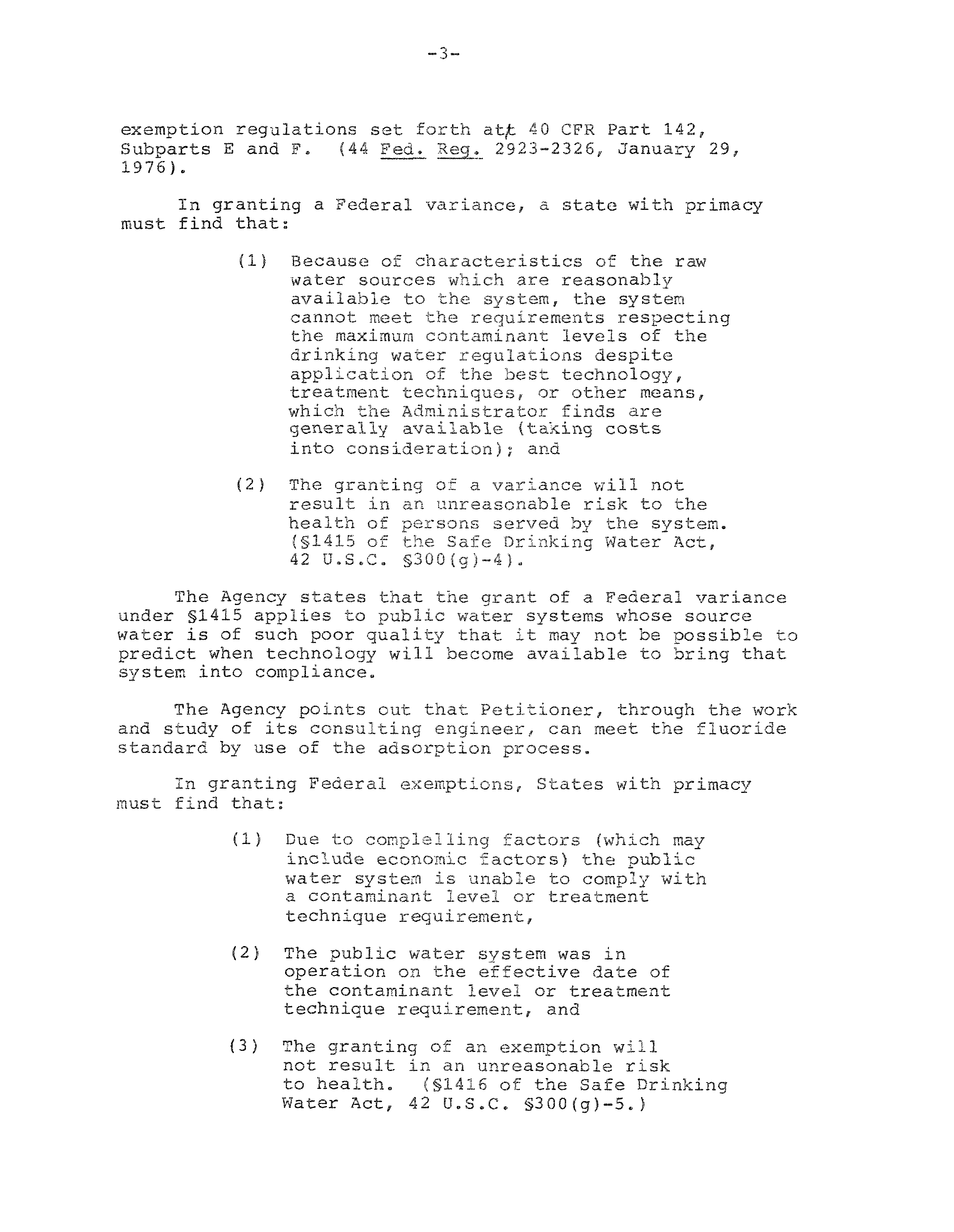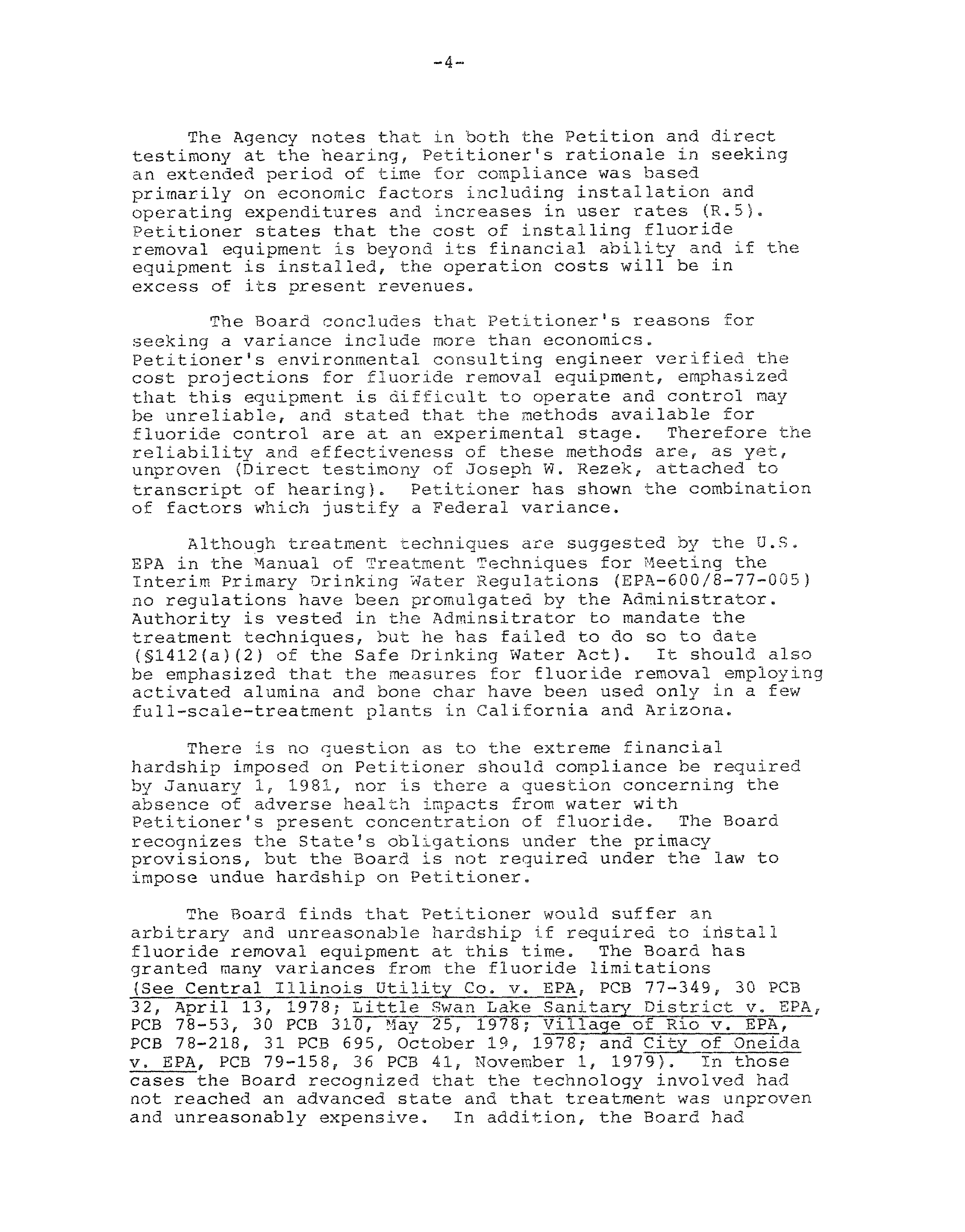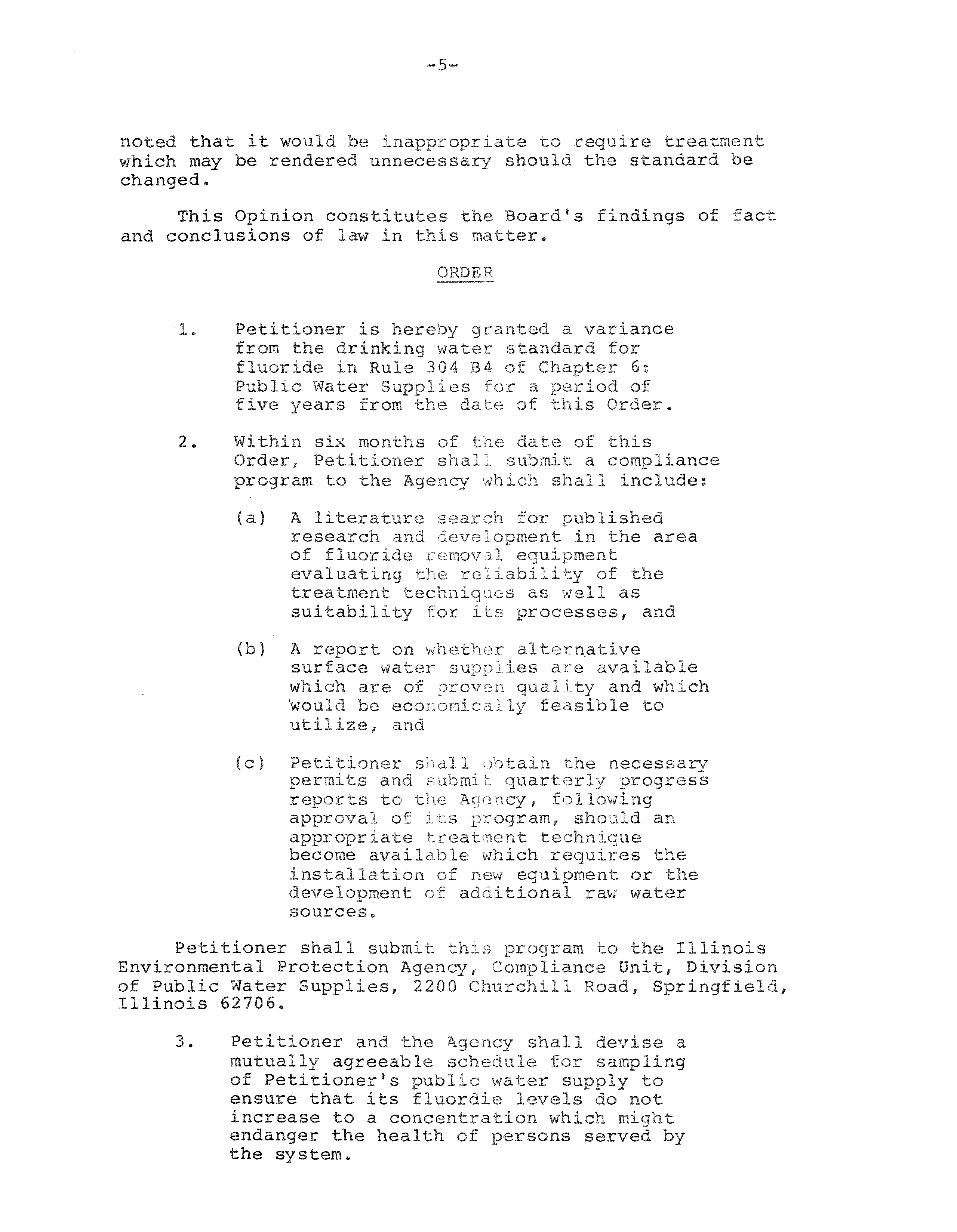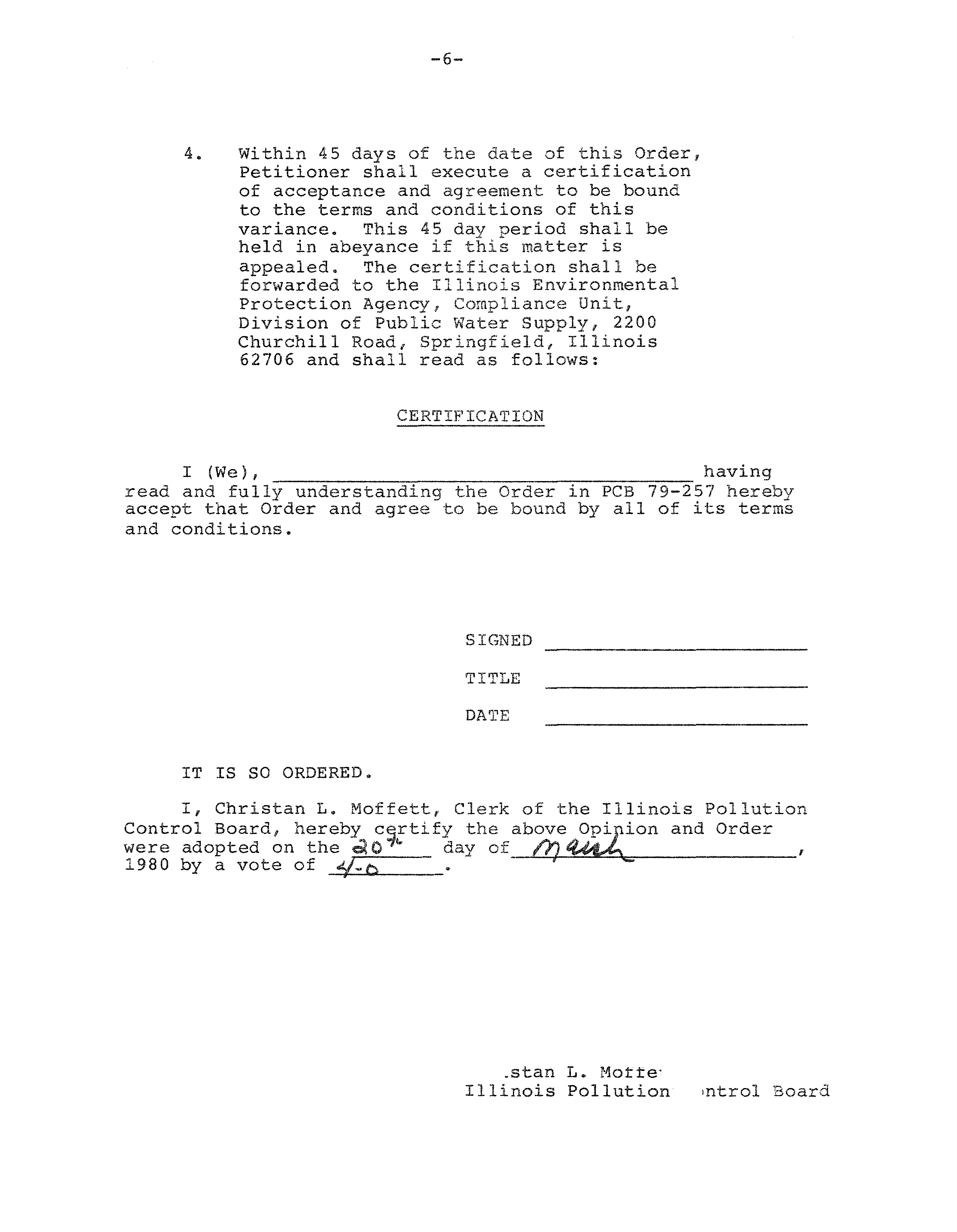ILLINOIS
POLLUTION CONTROL
BOARD
March
20,
1980
TURNBERRY UTILITIES,
INC.,
Petitioner,
v.
)
PCB
79~257
ENVIRONMENTAL PROTECTION AGENCY,
Respondent,
OPINION AND ORDER OF THE BOARD
(by Mr. Dumelle):
On December
4,
1979 Petitioner requested a variance
from the limitations for fluoride
in Rule 304
34
of Chapter
6:
Public Water Supplies for a period of five years,
The
Agency has recommended that a variance be granted until
January
1,
1981.
A hearing was held on February
20,
1980 in
Northbrook,
Illinois,
Petitioner provides public water utility service to a
subdivision located
in the village of Lakewood,
McHenry,
Illinois.
The water
supply serves approximately
75
single~familyhomes and certain recreational facilities,
The existing facilities consist of a 395 feet deep well with
a capacity of 325 gallons per minute and a 150,000
gallon
elevated storage tank and distribution system.
Raw water
from Petitioner~swell contains a natural
fluoride content
of approximately 2,72 mg!l.
Finished water contains
fluoride at approximately the same level
as raw,
A standard
of 2.0 mg/I
is presently required by Rule 304 34,
In order
to
comply with
the regulation, the installation and
operation of
a c~ntral system to remove fluoride
is
necessary.
Petitioner~sconsulting engineers reviewed
possible alternatives, and determined that the adsorption
process with the use of bone char media was the most cost
effective treatment technique.
Adsorption would involve
$204,365 in installation
costs which would require
additional revenues
of $75,993/year.
It
is projected by
Petitioner that each existing user would be charged
$84.50/month in addition to the present rates for water
service,
Petitioner and the Agency agree the fluoride removal
equipment
is costly.
They agree too that present fluoride
levels in Petitionervs system
are
not a health threat.
Petitioner points
out
that fluoride removal equipment
is
difficult
to operate and control
and may be unreliable.
There
is
no alternative surface—water supply available to
Petitioner
of proven water quality.
Petitioner would thus
be required to install the fluoride removal system which
would impose
a hardship on it due to the high costs of
installation and
difficulties
in operation.
A burden
would also be placed on those users of
the
system who
will
be charged additional
rates.
There is no dispute as to the granting of some form of
variance to Petitioner,.
At issue before the Board
is the
c1~iaracterizationof that variance under applicable Federal
law.
Petitioner contends that it seeks
a Federal variance
while the Agency
states that the Petitioner qualifies for a
Federal exemption.
Determination of this issue based on the
facts and relevant
law will provide Petitioner with either a
possible 5—year State variance or a January
1,
1981 deadline
for compliance with the requirements
of the public water
supply regulations concerning fluoride concentrations,
The
Board concludes that Petitioner~srequest should be
characterized as
a Federal variance for the reasons discussed
be
low.
In its Recommendation
dat.ed January
21, 1980 the Agency
stated its belief that the United States Environmental
Protection Agency
(USEPA)
may raise the permissible maximum
concentration level
for fluoride and that Congress may
extend the deadline for exemptions under the Safe Drinking
Water Act from the current date of January
1,
1981.
USEPA
has stated that aside from tooth mottling,
no adverse health
effects have been observed at fluoride levels
up to
8 mg/i.
Until further studies are completed,
the USEPA recommends
an
interim standard up to
4 mg/i providing excess tooth
mottling is not evident. The Agency believes that the
fluoride levels in Petitioner~ssupply should not produce
noticeable tooth mottling.
Since
the
Agency~sposition on
enforceable fluoride
limits
is to
allow interim levels at
approximately four times optimal
and because Petitioner~s
excursion over the existing limit
is minimal, the Agency
supports the granting of
a
State
variance as
a Federal
exemption.
However, because of the Agency~sobjections
under the delegation of primary enforcement responsibility
(primacy) and the requirements of Section 35 of the Act, the
Agency feels
it can recommend that the variance be granted
only until January
1,
1981,
The Agency points out
that until the maximum
concentration levels are raised,
it
is
obligated to observe
the existing federal standards under the USEPA~sgrant of
primacy for the public water systems
in the state.
Under
the
provisions of primacy and the limitations
in Section 35
of the Act,
the state must maintain a program at least as
stringent as that of
the Federal
government.
Thus, both
the
Agency
and the Board
must follow the Federal variance and
-3-.
exemption
regulations
set
forth
at~ 40
CFR
Part
142,
Subparts E and F.
(44
Fed.
!~9s 2923-2326,
January
29,
1976).
In
granting
a
Federal
variance,
a
state
with
primacy
must find that:
(1)
Because of characteristics of the
raw
water sources which are reasonably
available
to
the
system,
the
system
cannot
meet
the
requirements
respecting
the
maximum
contaminant
levels
of
the
drinking water regulations despite
application of the best technology,
treatment techniques, or other means,
which the Administrator finds are
generally available (taking costs
into consideration); and
(2)
The granting of a variance will not
result
in
an
unreasonable
risk
to
the
health of persons served by the system.
(S1415 of the Safe Drinking Water Act,
42 U.S.C. §300(g)—4).
The
Agency
states
that
the
grant
of
a
Federal
variance
under
§1415
applies
to
public
water
systems
whose
source
water
is
of
such
poor
quality
that
it
may
not be possible to
predict when technology will become available to bring that
system into compliance.
The Agency points out that Petitioner, through the work
and
study of its consulting engineer, can meet the fluoride
standard by
use
of the adsorption process.
In granting Federal exemptions, States with primacy
must find that:
(1)
Due to complelling factors (which
may
include economic factors) the public
water
system
is unable to comply with
a contaminant level or treatment
technique
requirement,
(2)
The
public water system was in
operation on the effective date of
the
contaminant
level
or
treatment
technique
requirement,
and
(3)
The
granting
of
an
exemption
will
not
result
in
an
unreasonable
risk
to health.
(S1416 of the Safe Drinking
Water Act,
42 U.S.C. §300(g)—5.)
—4—
The
Agency
notes that
in both the Petition and direct
testimony at the hearing,
Petitioner’s rationale in seeking
an
extended period of
time
for compliance was based
primarily on economic factors including installation and
operating expenditures and increases in user rates
(R,5).
Petitioner states that the cost of
installing fluoride
removal equipment
is beyond its financial ability and
if the
equipment is installed,
the operation costs will be in
excess
of its present revenues.
The
Board
concludes
that Petitioner
s reasons
for
seeking
a variance include more than economics.
Petitioner’s environmental consulting engineer verified the
cost projections for fluoride removal equipment,
emphasized
that
this
equipment
is
difficult
to operate and control
may
he
unreliable,
and
stated
that
the
methods
available
for
fluoride control
are at an experimental stage.
Therefore
the
reliability
and
effectiveness
of
these
methods
are,
as
yet,
unproven
(Direct
testimony
of
Joseph
W.
Rezek,
attached
to
transcript of hearing).
Petitioner has shown the combination
of factors which justify
a Federal variance,
Although treatment techniques
are
suggested
by the U
S.
EPA
in
the
Manual
of
Treatment
Techniques
for
Meeting
the
Interim
Primary
Drinking
Water
Regulations
(EPA—600/8—77—005)
no
regulations
have
been
promulgated
by
the
Administrator.
Authority is vested
in
the
Adminsitrator
to
mandate
the
treatment techniques, hut he has failed to do
so to date
(~14l2(a)(2)of the Safe Drinking Water Act),
It should also
be emphasized that the measures for fluoride removal
employing
activated alumina and bone char have been used only
in a few
full-scale-treatment plants
in California and Arizona.
There
is no question as to the extreme financial
hardship imposed on Petitioner should compliance he required
by
January
1,
1981,
nor
is there a question concerning the
absence
of
adverse
health
impacts
from
water
with
Petitioner’s present concentration of fluoride.
The Board
recognizes the State’s obligations under the primacy
provisions, but the Board
is not required under the law to
impose undue hardship on Petitioner.
The Board finds that Petitioner would suffer an
arbitrary and unreasonable hardship
if required to install
fluoride removal equipment at this time.
The Board has
granted many variances from the fluoride
limitations
(See Central
Illinois Utility Co.
v.
EPA,
PCB 77—349,
30 PCB
32, April
13,
1978; Little Swan Lake Sanitary District
v.
EPA,
PCB 78—53,
30 PCB 31~~1ay25,
1978T Vi lage of Rio v. EPA7~
PCB 78—218,
31 PCB 695, October 19,
1978;
and City
of Oneida
v.
EPA,
PCB 79—158,
36 PCB
41, November
1,
1979).
in those
cases the Board recognized
that the technology involved had
not reached an advanced state and that treatment was unproven
and unreasonably expensive.
In addition, the Board had
—5—
noted that it would be inappropriate to require treatment
which may be rendered unnecessary should the standard be
changed.
This Opinion constitutes the Board’s findings of fact
and conclusions of
law
in this matter.
ORDER
1.
Petitioner is hereby granted a variance
from the drinking water standard for
fluoride in Rule 304 84 of Chapter
6:
Public Water Supplies for a period of
five years from the date of this Order.
2.
Within
six
months of the date of this
Order,
Petitioner
shall
submit
a compliance
program
to
the
Agency
which
shall
include:
(a)
A literature search for published
research and development in the area
of fluoride removal equipment
evaluating the reliability of the
treatment
techniques as well as
suitability for its processes, and
(b)
~ report on whether alternative
surface water supplies are available
which are of proven quality and which
Would be economically feasible to
utilize, and
(c)
Petitioner shall obtain the necessary
permits and submit quarterly progress
reports
to
the
Agency,
following
approval
of its
program,
should
an
appropriate treatment technique
become available which requires the
installation
of
new
equipment
or
the
development
of
additional
raw
water
sources.
Petitioner shall submit this
program
to the Illinois
Environmental Protection Agency, Compliance Unit, Division
of Public Water Supplies, 2200 Churchill Road, Springfield,
Illinois 62706.
3.
Petitioner and the Agency shall devise a
mutually
agreeable
schedule
for
sampling
of
Petitioner’s
public
water
supply
to.
ensure that its fluordie levels do not
increase to a concentration which might
endanger the health of persons served by
the system.
—6—
4.
Within 45 days
of the date of this Order,
Petitioner shall execute
a certification
of acceptance and agreement to be bound
to the terms and conditions of
this
variance,
This
45 day period shall be
held in abeyance if
this matter is
appealed.
The certification shall be
forwarded to the Illinois Environmental
Protection Agency, Compliance Unit,
Division of Public Water Supply,
2200
Churchill Road,
Springfield,
Illinois
62706 and shall read
as
follows:
CERTIFICATION
I
(We),
having
read and fully understanding the Order in PCB
79—257
hereby
accept that Order and agree to be bound by all of its terms
and conditions.
SIGNED
—
TITLE
________________________
DATE
_________________________
IT
IS SO ORDERED,
I, Christan
L. Moffett,
Clerk of
the Illinois Pollution
Control Board, hereby c~rtifythe above Opi ion and Order
were adopted on the ~O~’
-
day
of_______________________
1980 by a vote of
_________
stan L, Matte
Illinois Pollution
ntrol
Board
